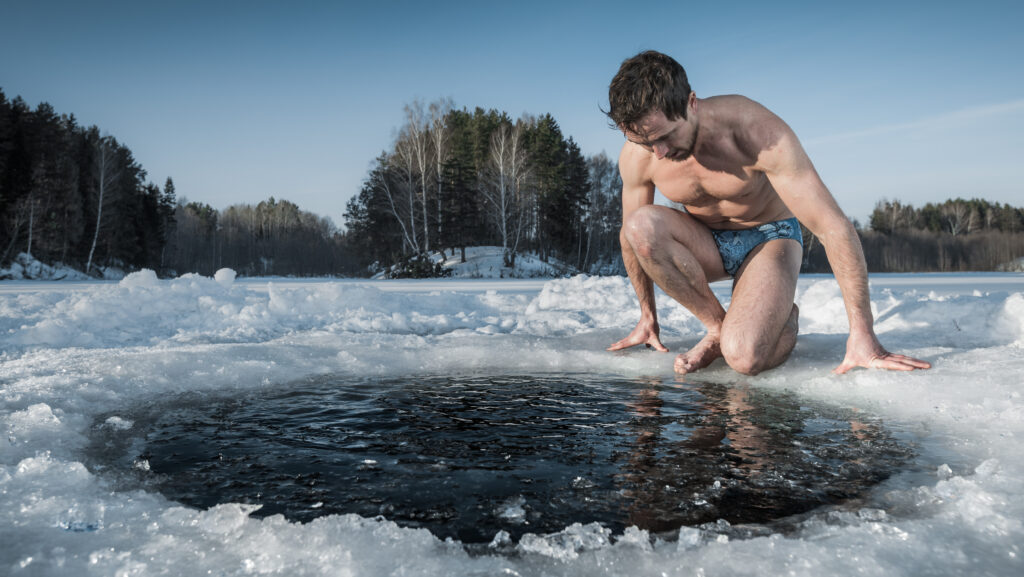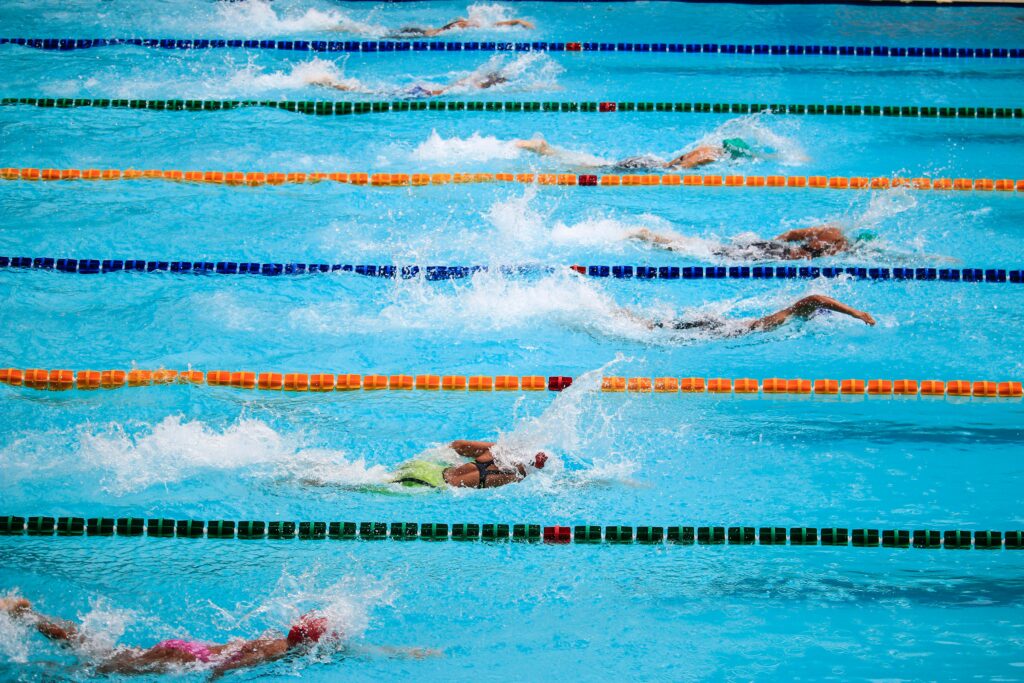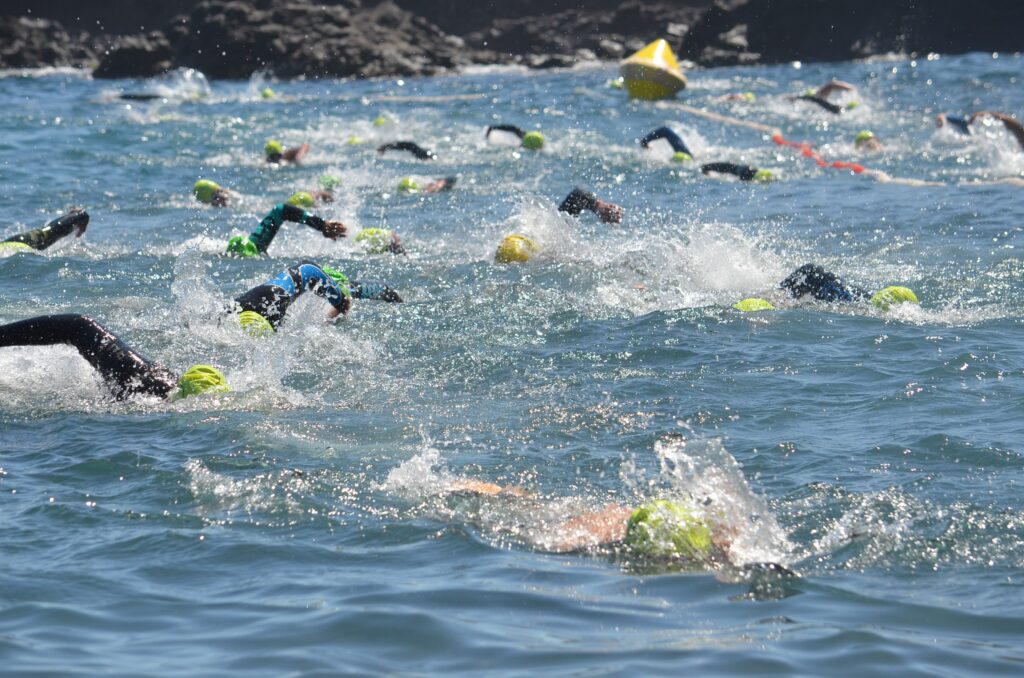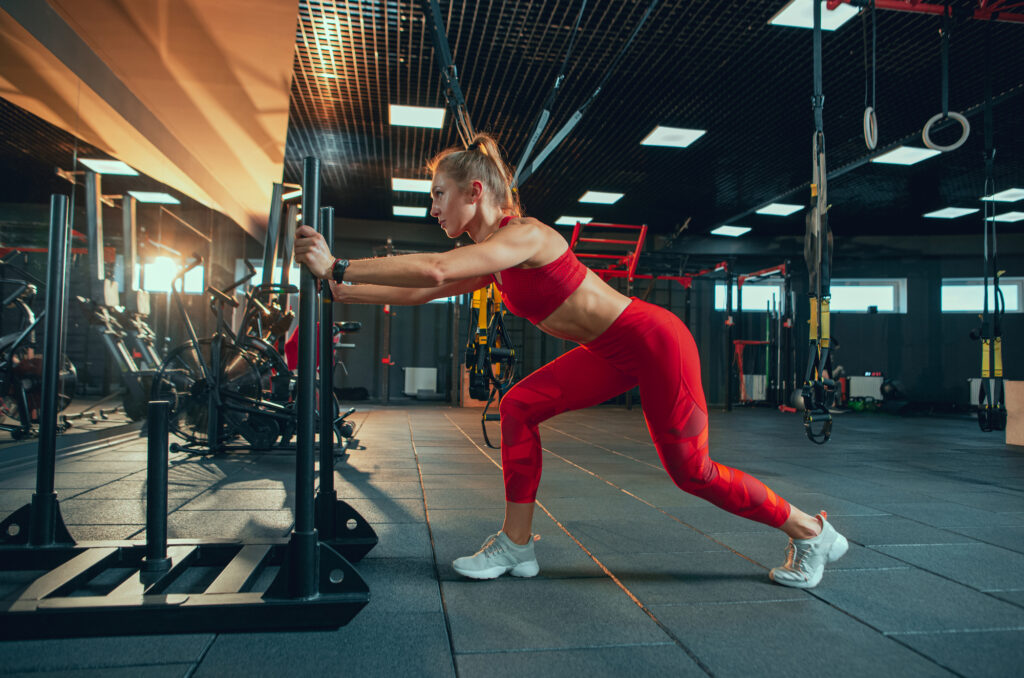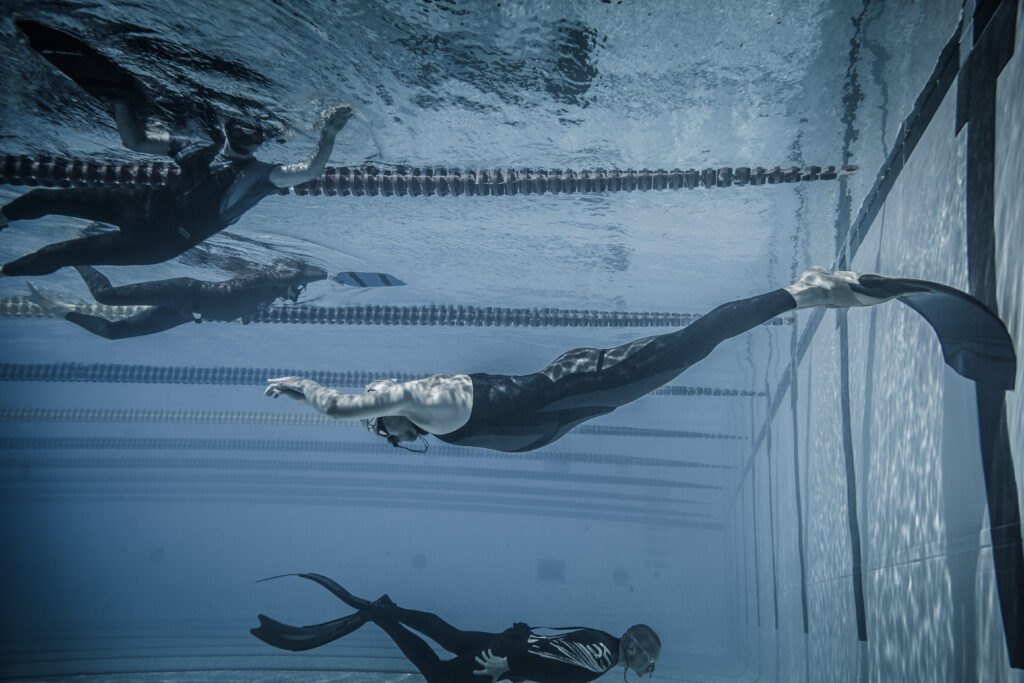The 200m breaststroke stands as one of swimming’s most demanding events, requiring swimmers to balance explosive power with tactical endurance over eight grueling lengths. Unlike shorter sprint distances, this race demands precise timing, power, and endurance whilst maintaining technical precision throughout the entire distance.
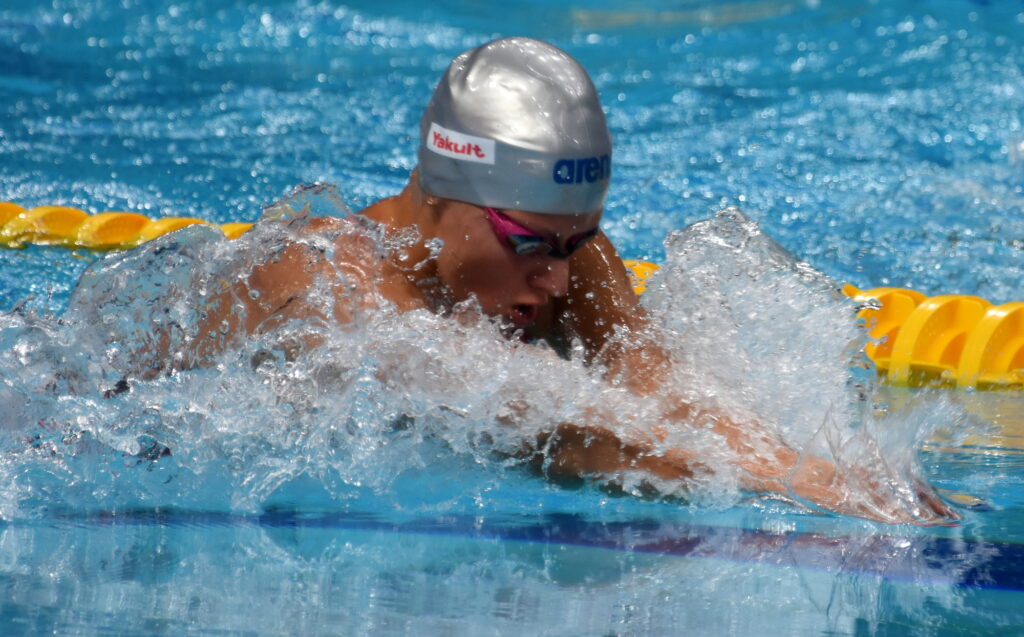
The key to improving 200m breaststroke performance lies in mastering stroke rate control, refining technical fundamentals, and developing race-specific endurance that allows swimmers to maintain speed through the final 50 metres. Many swimmers struggle with the unique challenge of this distance, often going out too fast or lacking the power to finish strong.
Success in the 200m breaststroke requires tailored race strategies that differ significantly from sprint approaches, combined with technical improvements across all aspects of the stroke. From optimising the kick and pull mechanics to developing race-specific power and endurance, swimmers must address multiple components to achieve meaningful time drops in this technically complex event.
Mastering 200m Breaststroke Race Strategy
Successful 200m breaststroke racing requires precise stroke rate control and strategic energy distribution across four distinct race segments. The key lies in controlling stroke rate at the right time whilst maintaining technical excellence throughout the race distance.
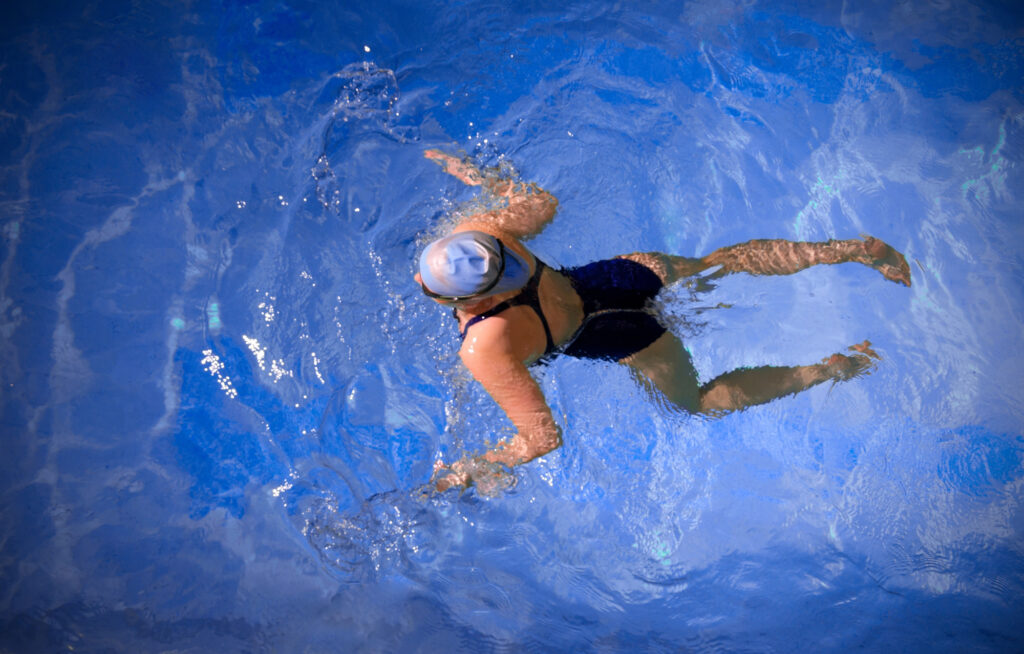
Optimising Stroke Rate for Race Distance
The 200m breaststroke demands a dramatically different stroke rate approach compared to sprint distances. Elite swimmers like Anton Chupkov demonstrate that fewer strokes can produce faster times when executed with proper technique.
Chupkov used approximately 30 cycles per minute during the first 150 metres. His Japanese competitors Koseki and Watanabe required 44 and 43 strokes respectively for the same distance. This 25% reduction in stroke count allowed Chupkov to conserve significant energy.
Optimal stroke rate progression:
- First 50m: 27-31 cycles per minute
- Second 50m: 30 cycles per minute
- Third 50m: 30-36 cycles per minute
- Final 50m: 43-52 cycles per minute
The final 25 metres require the highest stroke rate of the entire race. Chupkov reached 52 cycles per minute during his finishing sprint, higher than his competitors achieved at any point. This strategic acceleration pattern enables swimmers to unleash their saved energy when it matters most.
Pacing Approaches for Each Race Segment
The 200m breaststroke requires a back-loaded pacing strategy that emphasises the final 100 metres. Race strategy should focus on the back half with controlled aggression building throughout each segment.
First 50m: Swimmers should establish “easy speed” with smooth, long strokes. The emphasis remains on technical precision rather than aggressive pace. This segment sets up the entire race rhythm.
Second 50m: Maintain relaxed intensity whilst staying connected to the lead pack. Stroke rate should remain controlled around 30 cycles per minute. Avoid the temptation to match faster swimmers’ higher stroke rates.
Third 50m: Begin the race’s competitive phase with a gradual increase in intensity. Stroke rate can increase to 36 cycles per minute. Position becomes crucial as swimmers prepare for the final assault.
Final 50m: Execute the primary race move at the 100m mark. The last 25 metres demand maximum stroke rate and full energy expenditure. This segment determines race outcomes.
Utilising Race Analysis for Continuous Improvement
Systematic race analysis provides the foundation for strategic refinement and technical development. Swimmers must examine stroke count, split times, and stroke rate data from each race segment to identify improvement opportunities.
Key metrics to track:
- Stroke count per 50m segment
- Split times for each length
- Stroke rate progression throughout the race
- Underwater distance off each turn
Video analysis reveals crucial breaststroke technique elements that impact race performance. Swimmers should examine their gliding phases, body position during non-propulsive moments, and wave management skills. Elite swimmers like Chupkov excel at diving under their own waves to reduce drag resistance.
Race comparison analysis: Compare personal performances against competitors who use different strategic approaches. Examine how stroke rate variations affect split times and finishing positions. This data helps swimmers understand their optimal race execution patterns.
Training sessions should replicate race conditions using specific stroke rate targets. Practice different race strategies during time trials to determine which approach produces the fastest times. Consistent analysis creates measurable improvements in race execution and strategic decision-making.
Essential Breaststroke Technique Refinements
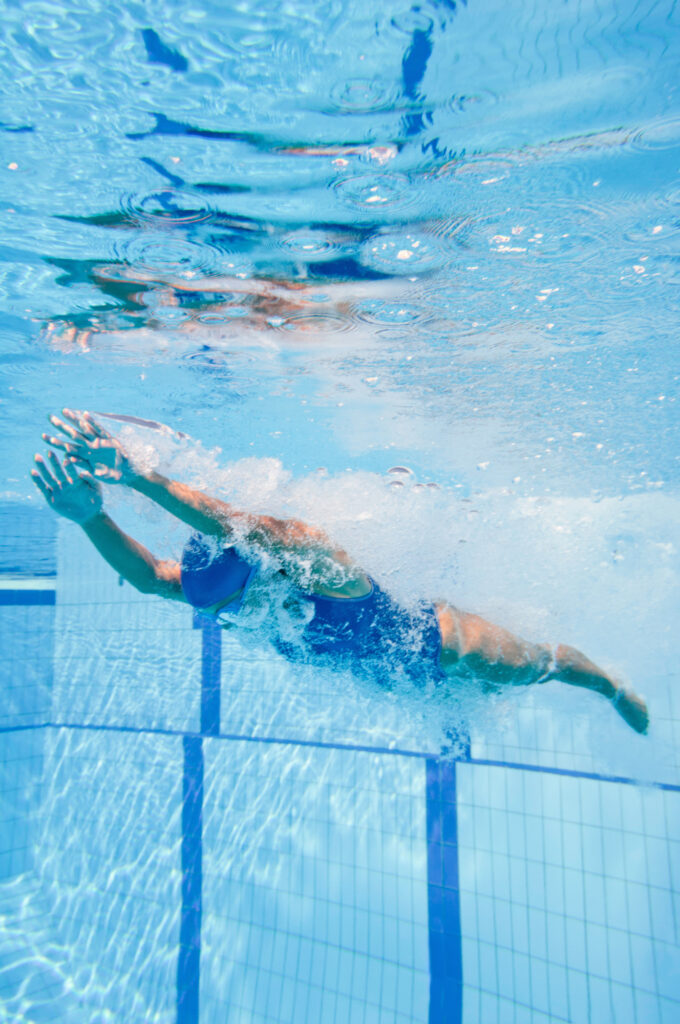
Proper breaststroke technique forms the foundation for success in the 200m event, where technical precision becomes crucial over the longer distance. Swimmers must focus on maintaining optimal body position, coordinating breathing patterns with stroke mechanics, and achieving perfect timing between arm pull and leg kick phases.
Improving Body Position and Alignment
Body position in breaststroke directly affects drag resistance and propulsion efficiency. The swimmer’s head should remain in a neutral position with eyes looking forward and down at approximately a 45-degree angle.
During the glide phase, the body must be completely horizontal with hips riding high near the water surface. Many swimmers allow their hips to drop, which creates significant drag and reduces speed.
The core muscles play a vital role in maintaining proper alignment. Swimmers should engage their abdominal muscles throughout the stroke cycle to prevent excessive undulation.
Key alignment points:
- Keep shoulders level and parallel to the water surface
- Maintain a straight spine from head to hips
- Avoid lifting the head too high during breathing
- Keep hips close to the surface during recovery
The streamlined position during the glide maximises the benefit from each stroke. Swimmers should extend their arms fully forward with hands together, creating the most efficient body shape possible.
Integrating Effective Breathing Mechanics
Breathing timing significantly impacts stroke rhythm and efficiency in breaststroke. The breath should occur naturally as part of the arm pull sequence, not as a separate action that disrupts the stroke.
Swimmers begin lifting their head as the hands start the outsweep phase of the breaststroke pull. The head reaches its highest point when the hands are at their widest position.
The key is to breathe forward rather than upward. This reduces the amount of head lift required and maintains better body position throughout the breathing cycle.
Breathing sequence:
- Head begins to lift during outsweep
- Mouth clears water surface during insweep
- Quick inhalation as hands sweep inward
- Head returns to water as hands extend forward
Swimmers should exhale gradually underwater between breaths. This prevents carbon dioxide buildup and maintains a relaxed breathing pattern throughout the 200m distance.
The chin should barely clear the water surface during inhalation. Excessive head lift creates drag and forces the hips to drop, disrupting the stroke’s efficiency.
Ensuring Proper Timing and Coordination
The coordination between arm pull and leg kick separates efficient breaststrokers from struggling swimmers. Controlling stroke rate becomes particularly important in the 200m event where pacing is crucial.
The arms and legs work in sequence rather than simultaneously. As the hands complete their pull and begin recovery, the legs prepare for the kick phase.
Timing sequence:
- Arms pull while legs remain extended
- Legs draw up as arms reach forward
- Powerful leg kick as arms extend into glide
- Brief pause in streamlined position
The glide phase allows swimmers to maximise distance per stroke whilst maintaining speed. Swimmers should feel themselves riding the wave created by their kick before beginning the next stroke cycle.
Breaststroke technique requires precise coordination to avoid fighting against one’s own movements. Poor timing creates turbulence and wastes energy that could propel the swimmer forward.
The most common timing error occurs when swimmers rush into the next stroke before maximising the glide phase. This reduces stroke length and increases stroke count, leading to faster fatigue over 200m.
Enhancing the Breaststroke Kick
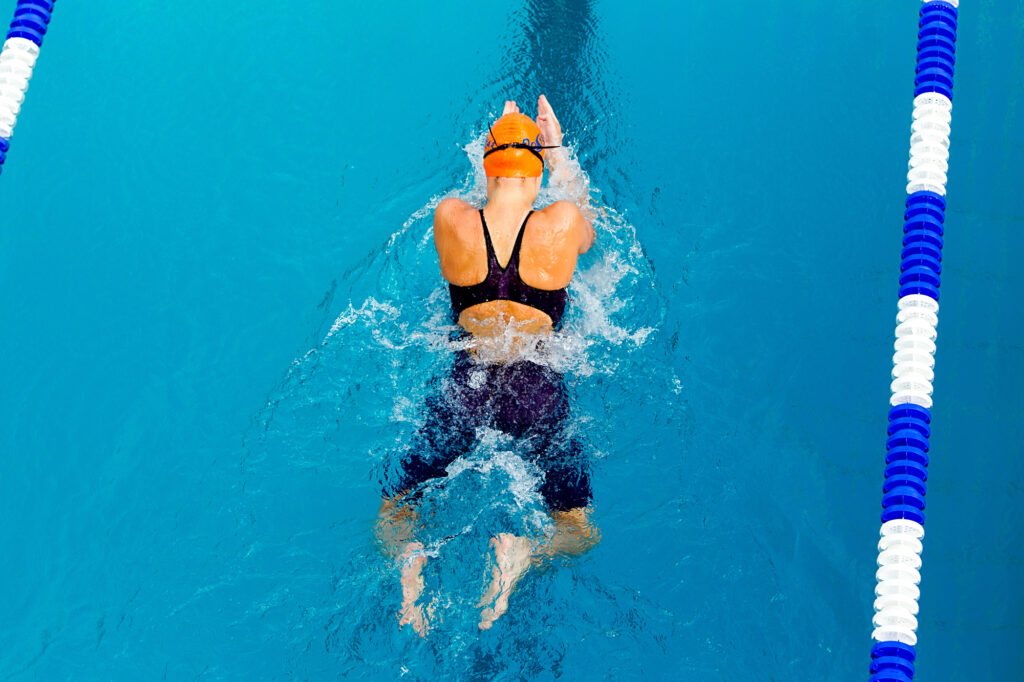
The breaststroke kick generates 70-80% of propulsion in the stroke, making it crucial for 200m performance. Swimmers must focus on maximising leg drive power, eliminating technique errors that create drag, and developing the flexibility needed for proper foot positioning.
Maximising Propulsion Through Leg Drive
The breaststroke kick’s power comes from explosive leg drive during the propulsion phase. Swimmers should engage their quadriceps and glutes to drive the kick backward rather than in a wide arc.
Key muscles for power generation:
- Quadriceps: Extend legs during backward push
- Glutes: Power the propulsion phase
- Hamstrings: Recover heels to hips quickly
- Adductors: Squeeze legs together at finish
The kick follows four phases: up, out, around, and together. During the propulsion phase, swimmers must push their feet directly backward using the insides of their feet and shins to press against the water.
Strength training improves kick power significantly. Squats target the primary muscles used in breaststroke kick. Swimmers should also incorporate glute kickbacks and adductor squeezes with resistance bands.
The finish phase requires snapping legs together with pointed toes. This creates a tight streamline position that reduces drag and sets up the next stroke cycle.
Correcting Common Kick Errors
Wide knees are the most common breaststroke kick mistake, increasing drag significantly. Swimmers should keep knees stable and shoulder-width apart whilst hinging at the knees rather than the hips.
Major technique errors to avoid:
- Rushing the setup before feet are turned out
- Kicking in circular motion instead of straight back
- Using dolphin or scissor kicks (illegal movements)
- Poor timing with arm stroke coordination
Many swimmers kick around rather than back, wasting energy through inefficient water displacement. The kick should follow a direct backward path for maximum speed.
Timing errors occur when swimmers kick whilst their arms are pulling. The kick should start as arms finish the pull and extend into streamline position.
Pull buoy drills help correct wide knees by placing the buoy high between the thighs. This forces swimmers to hinge at the knees whilst keeping feet wider than knees during the setup phase.
Improving Flexibility and Ankle Position
Ankle flexibility directly impacts kick effectiveness in breaststroke. Swimmers need sufficient dorsiflexion to turn their feet outward during the setup phase, creating maximum surface area for propulsion.
The tibialis anterior muscle controls foot positioning and often fatigues quickly in beginners. Daily stretching of hamstrings, glutes, and hip flexors improves kick range of motion.
Flexibility improvement exercises:
- Toe taps for tibialis anterior strength
- Calf stretches for ankle mobility
- Hip flexor stretches for better recovery
- Adductor stretches for wider foot positioning
Swimmers should turn their toes outward during the setup phase, positioning the insides and bottoms of feet to face backward. Feet should be wider than knees, roughly shoulder-width apart.
Wall kick drills improve flexibility whilst teaching proper knee hinging. Swimmers press their body against the pool wall and perform kicks, focusing on drawing heels to the outside of their hips.
Patient setup during the “out” phase allows proper foot positioning. Rushing this phase reduces the surface area available for propulsion and decreases overall kick effectiveness.
Optimising Breaststroke Pull and Arm Action
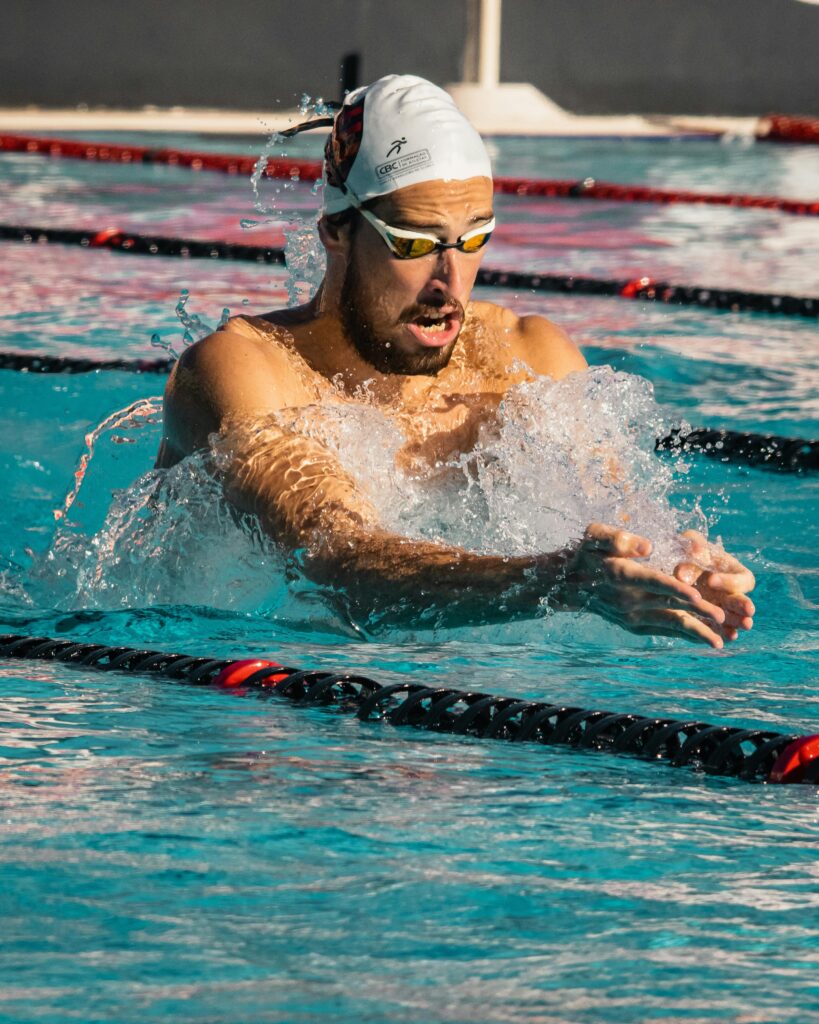
The pull phase generates crucial propulsion whilst maintaining rhythm in the 200m breaststroke. A high-elbow catch maximises water grip, proper hand recovery minimises drag, and consistent arm paths ensure balanced power distribution throughout the race distance.
High-Elbow Catch for Greater Efficiency
The catch phase determines how much water swimmers can grip and pull backwards. Elite swimmers maintain their elbows above their hands during the initial pull phase.
Swimmers should position their hands slightly wider than shoulder-width at the catch. The elbows stay high whilst the hands pitch downward at approximately 45 degrees.
Key catch positions:
- Hands 6-8 inches below water surface
- Elbows remain above hand level
- Forearms create a paddle-like surface
The breaststroke pull technique requires engaging the latissimus dorsi muscles during the insweep phase. This creates maximum propulsion as hands sweep inward toward the chest.
Hand paddles can help swimmers develop proper catch mechanics during training. The added resistance forces proper elbow positioning and strengthens the pulling muscles.
Swimmers often drop their elbows too early, reducing their effective pulling surface. Maintaining the high-elbow position throughout the catch and insweep phases maximises forward propulsion.
Hand Recovery and Streamlining
Recovery begins immediately after the insweep phase completes. Hands should shoot forward quickly whilst staying close to the water surface.
The hands must return to full extension before the next stroke cycle begins. This streamlined position reduces drag and maintains momentum between strokes.
Recovery checklist:
- Hands extend fully forward
- Arms return to shoulder-width apart
- Brief glide maintains rhythm
- Minimal splash during recovery
Swimmers should avoid lifting their hands too high during recovery. Keeping hands just above or at water level reduces air resistance and maintains body position.
The recovery timing coordinates with the breathing cycle. As swimmers exhale underwater, their hands should complete the forward extension into the glide position.
Poor recovery technique creates unnecessary drag that slows swimmers throughout the 200m distance. Smooth, controlled hand recovery maintains the stroke’s natural rhythm.
Maintaining Symmetry and Path Consistency
Both arms must follow identical pulling patterns to maintain straight swimming lines. Asymmetrical pulls cause swimmers to veer left or right in their lanes.
The outsweep phase should be equal on both sides. Hands move outward symmetrically before transitioning into the catch position.
During the insweep, both hands should reach the same depth and follow parallel paths toward the chest. Uneven pulling reduces overall efficiency.
Symmetry markers:
- Equal outsweep width on both sides
- Matching hand depths during catch
- Parallel insweep paths
- Simultaneous recovery timing
Swimmers can practise single-arm breaststroke drills to identify differences between their left and right arm actions. This breaststroke technique isolation helps correct imbalances.
Video analysis reveals subtle asymmetries that swimmers cannot feel during training. Recording underwater footage shows exact hand paths and timing differences.
Consistent arm paths become increasingly important as fatigue builds during the 200m race distance. Maintaining technical precision prevents stroke breakdown in the final 50 metres.
Targeted Breaststroke Drills for the 200m
The 200m breaststroke demands precise timing, explosive power bursts, and sustained endurance throughout four lengths. Swimmers need specific drills that develop coordination between arms and legs, build strength for powerful strokes, and integrate resistance tools to maximise training effectiveness.
Drills to Improve Timing and Coordination
Proper timing separates good breaststrokers from great ones in the 200m event. The stroke requires perfect synchronisation between the pull, breathe, kick, and glide phases.
Two-Kick, One-Pull Drill helps swimmers feel the natural rhythm. Swimmers perform two breaststroke kicks for every arm pull. This drill forces proper timing and prevents rushing through stroke cycles.
Wall Timing Drill develops coordination at race pace. Swimmers face the pool wall and practice the complete stroke sequence. They focus on the timing between the pull finishing and kick starting.
Pause Drill teaches stroke patience. Swimmers hold their arms extended forward for three seconds after each kick. This builds the discipline needed for controlling stroke rate during different phases of the 200m race.
Sculling with Kicks improves feel for the water. Swimmers perform small sculling motions whilst maintaining proper breaststroke kick timing. This drill enhances coordination between upper and lower body movements.
Drills for Explosive Power and Endurance
The 200m breaststroke requires both explosive power for fast splits and endurance to maintain technique. Swimmers must develop strength whilst building the stamina needed for four lengths.
Vertical Breaststroke Kicking builds leg power and endurance simultaneously. Swimmers tread water using only breaststroke kicks for 30-60 seconds. Advanced swimmers keep their hands above their heads to increase difficulty.
Sprint-to-Glide Intervals develop explosive power. Swimmers sprint the first 15 metres of each 25m length, then glide to the wall. This mirrors the power demands of racing whilst teaching efficient gliding.
Resistance Band Kicks create explosive strength in the breaststroke kick. Swimmers attach resistance bands around their ankles and perform kicks against the added resistance. This builds the fast-twitch muscle fibres needed for sprint portions of the 200m.
Underwater Pullout Extensions enhance power and lung capacity. Swimmers perform extended underwater phases with multiple dolphin kicks after each turn. This builds the strength needed for powerful race starts and turns.
Integrating Resistance Tools and Hand Paddles
Resistance tools and hand paddles help swimmers develop the specific strength patterns needed for 200m breaststroke racing. These tools must be used correctly to avoid stroke disruption.
Hand Paddles for Power Development increase resistance during the pull phase. Swimmers use medium-sized paddles whilst maintaining proper stroke technique. The increased resistance builds pulling power without significantly altering stroke mechanics.
Pull Buoy Sets isolate upper body development. Swimmers use pull buoys during arm-only breaststroke sets. This builds pulling endurance whilst allowing legs to recover between kick-focused sets.
Drag Suit Training creates full-body resistance. Swimmers wear drag suits during technique sets to increase water resistance. This builds strength throughout the entire stroke cycle whilst maintaining proper timing.
Parachute Resistance Swims develop race-specific power. Swimmers attach small parachutes during 50m repeats at race pace. The added resistance forces stronger strokes whilst building the power needed for negative splitting in the 200m event.
Developing Power, Strength, and Endurance
Success in the 200m breaststroke requires swimmers to build explosive power for fast starts and turns, develop specific strength for the breaststroke pull and kick, and maintain endurance to sustain speed throughout the race. Training must target both land-based strength development and pool-based power work to maximise race performance.
Land-Based Strengthening for Breaststroke
Swimmers need specific strength training that mirrors the demands of breaststroke movement patterns. The breaststroke pull requires strong latissimus dorsi, rhomboids, and pectorals to generate forward propulsion.
Key exercises for breaststroke pull strength:
- Pull-ups and lat pulldowns
- Seated cable rows
- Chest press variations
- Medicine ball slams
The breaststroke kick demands powerful hip adductors, glutes, and quadriceps. Swimmers should focus on exercises that develop these muscle groups whilst improving flexibility.
Essential breaststroke kick exercises:
- Squats and goblet squats
- Hip adductor machine work
- Frog jumps
- Cossack squats for hip mobility
Plyometric exercises build the explosive power needed for race starts and underwater phases. Box jumps, broad jumps, and medicine ball throws develop the rapid force production that translates to faster swimming.
Training frequency should be 2-3 sessions per week during base training periods, reducing to 1-2 sessions during competition phases.
Swimming Sets for Building Race-Specific Endurance
Building breaststroke endurance requires swimmers to develop the ability to maintain stroke technique and speed over 200 metres. Training sets should progress from aerobic base building to race-pace work.
Base endurance sets:
- 8 x 100m breaststroke at moderate pace (15-20 seconds rest)
- 4 x 200m breaststroke building each 50m
- 12 x 50m breaststroke on tight rest intervals
Race-pace training:
- 4 x 50m at 200m race pace (30 seconds rest)
- 3 x 100m at goal 200m pace (45 seconds rest)
- Broken 200m swims (4 x 50m with 10 seconds rest at race pace)
Swimmers should incorporate stroke count awareness during endurance sets. Maintaining consistent stroke length whilst swimming at target paces develops the efficiency needed for 200m success.
Progressive overload involves gradually increasing distance, reducing rest intervals, or swimming at faster paces. This systematic approach builds the specific endurance required for competitive 200m breaststroke racing.
Power-Based Workouts Incorporating Dolphin Kick
The dolphin kick provides significant underwater speed advantage after starts and turns in breaststroke racing. Swimmers can legally use dolphin kick for one stroke cycle after each wall push-off.
Dolphin kick power development:
- 8 x 25m underwater dolphin kick (maximum distance)
- 4 x 15m dolphin kick sprints off each wall
- 6 x 50m breaststroke with emphasis on underwater phase
Power training should focus on explosive dolphin kick rhythm rather than distance. Short, intense efforts develop the fast-twitch muscle fibres needed for effective underwater swimming.
Combined power sets:
- 10 x 25m: dolphin kick to 15m, then sprint breaststroke
- 6 x 50m: fast underwater dolphin kick off each wall
- 4 x 75m: build dolphin kick speed through each length
Swimmers should practise transitioning smoothly from dolphin kick to the first breaststroke pull. This technical skill becomes crucial during race situations when maintaining momentum is essential.
Regular power training sessions (2-3 per week) help swimmers develop the explosive capability needed for competitive 200m breaststroke performance.
Frequently Asked Questions
Swimmers training for the 200m breaststroke often need specific guidance on training sets, drills, and workout modifications. These questions address the most common concerns about building endurance, improving technique, and adapting training programmes for optimal performance.
What are effective training sets for enhancing performance in the 200m breaststroke?
Distance-based sets help build the aerobic capacity needed for 200m events. Swimmers should focus on 4 x 100m breaststroke with 20-30 seconds rest between each repeat.
Broken 200m sets allow swimmers to practise race pace whilst maintaining proper technique. They can swim 4 x 50m at 200m race pace with 10 seconds rest between each length.
Pyramid sets build both speed and endurance effectively. A typical pyramid includes 50m, 100m, 150m, 200m, 150m, 100m, 50m with decreasing rest intervals as distances get shorter.
Which breaststroke drills can specifically improve my timing and coordination?
The pull-breathe-kick-glide drill breaks down the stroke sequence into distinct phases. Swimmers pause briefly between each movement to establish proper timing patterns.
Single-arm breaststroke with the non-working arm extended helps swimmers focus on timing without rushing through the stroke cycle. This drill improves coordination between the pull, breathe, and kick phases.
Vertical kicking drills in deep water strengthen the kick whilst teaching proper timing. Swimmers perform breaststroke kicks whilst treading water, which improves technique and timing.
How can I increase my speed in breaststroke races?
Stroke rate control at different race segments produces faster times. Swimmers should maintain controlled stroke rates early in races and increase turnover in the final 50m.
Underwater dolphin kicks after starts and turns add significant speed. Swimmers can perform up to 15m underwater with one pullout and dolphin kick combination.
Reducing glide time whilst maintaining stroke length increases overall speed. Swimmers should shorten their glide phase gradually as they build fitness and strength.
Sprint sets of 25m and 50m repeats at maximum effort improve top-end speed. These short distances allow swimmers to focus on power without compromising technique.
Can you suggest competitive breaststroke workouts that focus on endurance and power?
Power endurance sets combine strength and stamina training. Swimmers can perform 8 x 75m breaststroke building each 25m (easy, moderate, hard) with 15 seconds rest.
Lactate threshold sets help swimmers maintain speed over 200m distances. A typical set includes 6 x 100m breaststroke at moderate-hard effort with 30 seconds rest.
Mixed distance ladders build race-specific fitness. Swimmers progress through 50m, 100m, 150m, 200m, then back down, maintaining consistent pace throughout.
Pull-only sets with paddles and pull buoy develop upper body power. Swimmers perform 10 x 50m breaststroke pull at high intensity with 20 seconds rest.
What is the best way to structure a breaststroke sprint workout for optimal results?
Short rest intervals between repeats maintain elevated heart rates whilst allowing technique focus. Sprint sets should include 30-45 seconds rest for 25m repeats and 60-90 seconds for 50m repeats.
Progressive building sets prepare swimmers for race conditions. They can swim 4 x 50m building speed every 12.5m, starting at 70% effort and finishing at 95%.
Race pace simulation sets help swimmers practise competitive speeds. A typical set includes 8 x 25m at 200m race pace with 20 seconds rest.
Technical emphasis during sprint work prevents stroke breakdown at high speeds. Swimmers should maintain proper timing and stroke length even during maximum effort repeats.
In what ways can I modify my 100m breaststroke training to better suit the 200m event?
Longer training distances build the aerobic base required for 200m events. Swimmers should increase their primary training distances from 50-100m repeats to 100-200m repeats.
Extended warm-up and cool-down periods help swimmers adapt to longer training sessions. Training for 200m events requires specific preparation that differs from shorter sprint distances.
Negative split training teaches swimmers to finish faster than they start. They should practise swimming the second half of training sets faster than the first half.
Tempo control work helps swimmers manage their stroke rate over longer distances. They can use tempo trainers to practise holding consistent stroke rates during 200m repeats.
Recovery intervals between main sets should increase to allow for the higher training volumes needed for 200m preparation. Swimmers need 2-3 minutes recovery between intense 200m repeats compared to 60-90 seconds for 100m training.

